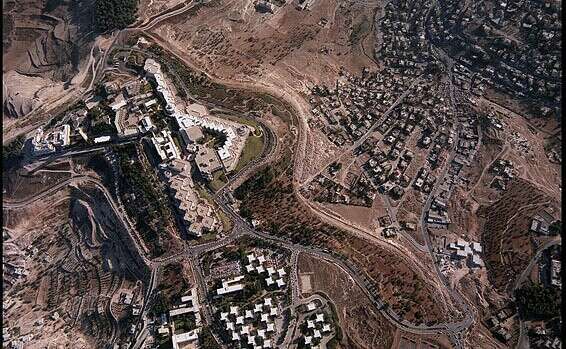In the heart of cities across the country stand desolate areas and abandoned buildings, which could have become sought-after projects
Goldmint House.
Amazing location on the beach
Photo:
Wikipedia
Produced by the Department of Special Supplements
In light of the continued price increases in the real estate market in Israel and the expectation of further increases in the coming year, we conducted a comprehensive examination of wasted areas in Israel, which if approved construction of real estate, hotels, shopping centers and offices, would increase the supply of properties in demand areas.
The test was conducted with the assistance of the research department of the Snir company.
According to Nir Shmol, CEO of the company: "The construction option in these specific locations may perhaps slightly improve the chance of a reduction in the costs that customers pay for the purchase of the apartments."
Want to stay up to date all the time?
Sign up for the Real Estate Newsletter today
Talk real estate with Ofer Petersburg. Listen to the new podcast >>
Jerusalem: The Hebrew University
The Hebrew University of Jerusalem was established in 1925 and is the first public university established in Israel and the second academic institution after the Technion.
The university is located in two locations in Jerusalem, one campus on Mount Scopus and the other in Givat Ram.
The Hebrew University owns the Mount Scopus campus in Jerusalem - 722 dunams, the Safra campus in Givat Ram - 597 dunams, the Faculty of Agriculture in Rehovot - 446 dunams and the Ein Kerem campus in Jerusalem - 101 dunams.
These are huge areas, in which it was possible to build a very large number of real estate buildings and develop residential, office and commercial environments. The same is true of all the large universities in Israel, which are in the heart of the demand areas.
Despite the university's cumulative debt of about NIS 12.5 billion, which relates mainly to the actuarial deficit of the pension payment to university employees, this institution owns land areas worth billions of shekels, most of which are not used.
It is important to note, however, that most of these real estate areas were purchased in the beginning, through donations, so there is a fundamental question about the possibility of selling the areas in favor of huge real estate projects.
Recently, as part of an agreement with the Israel Land Authority regarding rights to use and return land, the university is expected to rake in hundreds of millions of shekels.
The university will return to Rami the land it leased from Givat Ram and Mount Scopus, to enable it to advance construction plans for about 2,000 apartments, offices and commercial areas. It is estimated that the marketing of the land will generate NIS 1.5 billion in revenue for the university.
In 2019, the university launched a tender for the establishment of a business park in Givat Ram in an area of approximately 150,000 square meters. This is the first tender of its kind in Israel on a university premises.
Tel Aviv: The old central station
In 1938, a decision was made in the Tel Aviv Municipality: to establish the first central bus station in the city.
The location chosen was near the Neve Sha'anan neighborhood.
The goal was to gather in one place all the small terminals that were scattered throughout the city, and especially the one which is located on Rothschild Avenue.
The choice of this location was due to the fact that the city buses were parked in this area and in light of the geographical proximity to the Colonies Square, from which most of the bus lines departed in the various directions of travel.
In 1963 they realized that the old station was no longer suitable for the city and began planning for the new Central Station.
After the opening of the new Central Station in 1993, most of the bus lines as well as the service taxis to the various destinations moved to the new station.
At the old station, a few lines of Dan and Egged remained.
In light of the emptying of all means of transportation from the old station, most of the area was routed in favor of a parking lot for vehicles and buses, and the offices were used by the Egged Cooperative.
In 2001 three platforms of the old station were demolished and the desolate place became the center of many foreign workers, living near this space.
In July 2009, the Tel Aviv-Yafo municipality planned to demolish the remaining wharves from the old central station so that no trace of the historic building remains, but the demolition was not carried out in the end following a restraining order issued by the newspaper store owners, which was located in the underground tunnel.
On July 31, 2009, the old central station in Tel Aviv was finally closed, after Egged's last lines were also transferred to other terminals, such as the Wolfson terminal in Holon and the Arlozorov terminal in Tel Aviv.
At the station in the old central station, the companies Levinstein and Shikun VeBinui will build 1,400 apartments, including long-term rent.
The district committee approved the construction plan for the Central Station area, which will include 90,000 square meters of commercial space and 1,423 apartments.
Ramat Gan: The football stadium
A plan to demolish the Ramat Gan stadium and build an employment zone in its place has been on the brink for two years.
The football stadium was inaugurated in 1950, and has 41,583 seats.
The western stand, which includes 13,370 seats, was rebuilt and inaugurated in 1984. The excellent location of the stadium is adjacent to the Ayalon Mall and it also houses the offices of the Football Association.
Until 2014, the stadium served as the official national stadium of the Israeli team and many national events took place there, including the Maccabiah Games.
The stadium covers an area of about 7 dunams, and it overlooks the views of the Yarkon Park and is located near the luxury neighborhoods of Tel Aviv.
In 2017, the Ramat Gan municipality decided to demolish the stadium and build office towers in its place.
In 2018, the current mayor, Carmel Shama HaCohen, stated that he prefers to advance plans to upgrade the stadium.
In June 2019, a reverse decision was made again, that the stadium would still be demolished, but it has not yet been determined how this quality space will be utilized.
This is one of the best land reserves in Israel.
The proximity of the area to Bnei Brak, which is across the road with its large employment complex, may lead to construction that combines a mix of commercial, employment and residential uses.
In Israel, there are many stadiums and old sports facilities, which are located in the city centers with tremendous real estate value.
Haifa: Bat Galim Central Station
The Mordechai Ofer Central Station is located in the Bat Galim neighborhood of downtown Haifa.
Between 1974 and 2003, it served as a central station for passengers inside and outside the suburbs of Haifa.
The building was designed a few years earlier by Sharon-Idelson Architects together with Rozov-Freiberger.
The unusual construction design was carried out by the engineer Asher Milstein from the office of the engineers "A. Milstein - A. Singer".
When the station was established, it had offices, shops, a ballroom, a post office and two bank branches.
The municipal platforms are located at the top of the station.
An underground passage created a convenient connection to the train station.
Over the years, two main stations were established in its place - Hof Hacarmel and Hamifratz.
Bat Galim station became redundant.
Now the building, which belongs entirely to the army, is abandoned and inactive.
Netanya: Goldmintz House
The Goldmintz House was established in the 1950s thanks to the contribution of Rumi Goldmintz, a resident of Antwerp, who contributed to its establishment for the youth aliyah and Holocaust survivors and decided to establish an art museum in the city as well.
With Goldmintz's death, and in light of the fact that not many visitors came to the museum, the Goldmintz House was transferred to the operation and management of the Association for the Soldier.
For many years this building served as a recreation facility for soldiers and also a leadership development school.
The soldiers enjoyed vacations in the 88 air-conditioned rooms, dozens of classrooms, a club, a cafeteria, two dining rooms, a synagogue and a 360-seat movie theater.
The place has changed its designation from time to time, as needed.
During the Six Day War and the Yom Kippur War, the army used the place as a recovery facility for wounded soldiers.
During the summer holidays, camps were held there for orphaned children of the victims of the Israeli military.
Today, the compound serves as a corona lodge for IDF soldiers in isolation.
There is no doubt that the location of the complex on a cliff overlooking the Mediterranean Sea, on one of the most beautiful beaches in Israel, next to the newest and most sought after neighborhoods in Netanya, is a huge real estate for the development of hotels and luxury residences with sea views.
Eilat: Navy Camp
The naval base was built more than 60 years ago in the heart of the southern city.
Nearby are the leading neighborhoods of Eilat.
Had the base been vacated and residential buildings built on this land, there would probably have been a great demand for these apartments in view of their excellent location.
The strategic location of the base, close to the promenade and the hotels, prevents the expansion of the promenade and the establishment of additional hotels, shopping and entertainment centers in this area.
Although it has been reported that in 2019 the base will be relocated to another location or reduced, in order to establish a holiday village and for beach accessibility, this has not yet happened.
The Israel Ports Company returns approximately 235 dunams to the state for the future development needs of Eilat: the areas between the naval base and the stairway area of Eilat Port (approximately 160 dunams), the Palm Beach, Electricity Beach and Mosh beach, including areas leased to the Port Beach Development Company , Mekorot and the Salt Land Company (34 dunams), area in the Shachmon neighborhood (8 dunams), area in accordance with the Infrastructure Law for the transmission and storage of oil of the EPA complex (34 dunams)
In February of this year, the local committee in the Eilat municipality approved the plan for the new neighborhood that is expected to be built on the territory of the Israel Ports Company, which will be vacated.
In the plan: diverting Route 90 to the neighborhood and creating a new bathing beach, while combining residential, commercial and hotels within touching distance of the beach.
Across the country: public buildings
For years, public buildings such as kindergartens, schools, day care centers, milk drops, synagogues and more have been built on thousands of dunams that are active for only a few hours each day.
Recently, the cities of Gush Dan have begun to design public buildings in a designated division on the various floors of each building.
For example, a particular building is inhabited by people and also has a school, library or kindergarten.
But we have more than 10,000 dunams of land in Israel that are routed for the benefit of the activities of public buildings, which are active only about 25% of the time.
What could we have done if we had concentrated these uses in 50% of the area, that is, in high-rise construction or alternatively in the land areas of the buildings?
This is an addition of hundreds of thousands of housing units in the city centers and in the old neighborhoods.
Not to mention rental housing for young people and the homeless.
5,000 dunams double 50 housing units per dunam is worth 250,000 small housing units for rent.
This is a dramatic addition of housing units to the State of Israel, which will help lower real estate prices and add housing places, especially for young couples.
Produced by the Department of Special Supplements








